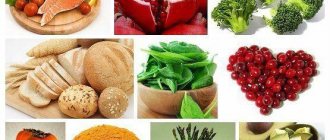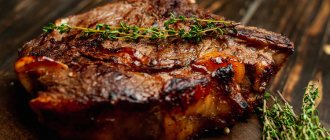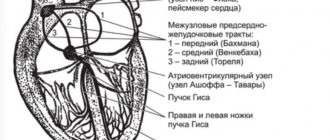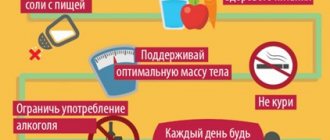Cardiovascular diseases rank first in terms of mortality due to health problems. Strokes, heart attacks, coronary heart disease, and arterial hypertension claim millions of lives around the world every year. And something definitely needs to be done about this!
The ideal solution is early prevention of such diseases, the main role of which is given to proper balanced nutrition. If a person was born without heart defects, then in adulthood almost all cardiovascular diseases that he acquired are in one way or another related to his diet and lifestyle.
Let's take care of our healthy diet and regular activity from a young age, then most problems can be avoided. However, when time is already lost, the best thing you can do is to switch to a special diet for heart disease, which will protect your heart from unnecessary nutritional shocks.
Today, experts from the School of Nutritionists of the Wellness Consulting Academy
They will tell you what therapeutic nutrition should be like for diseases of the heart and blood vessels, and what you need to eat to ease their course and prevent dangerous complications.
Why is it important to adhere to therapeutic nutrition for heart disease?
One of the main goals of therapeutic nutrition is to enhance the effect of taking medications prescribed by a doctor. In some cases, with a properly selected diet, it is possible to do without medications altogether or significantly reduce their amount and period of use. For this reason alone, it is worth listening to the advice of an experienced nutritionist and switching to a therapeutic diet immediately after making the appropriate diagnosis.
A nutritionist will help develop a treatment menu and the required level of physical activity at which the load on the heart and blood vessels will be optimal. In addition, a nutrition consultant will tell you which habits you should give up right now.
These include smoking, drinking alcohol, overeating, abuse of simple carbohydrates, leading to obesity and insulin resistance ( diabetes mellitus
is an aggravating factor in cardiovascular diseases).
Another important task of diet therapy is the correction of metabolic disorders that inevitably arise with such diagnoses, relieving the heart from excessive stress, and improving the absorption of food through proper diet.
Thanks to a special diet, it will be possible to normalize weight, lower blood pressure, reduce lipid and blood sugar levels, and reduce the susceptibility to thrombosis. All this will certainly affect your well-being and general health, and will also significantly reduce the risk of developing serious cardiovascular pathologies and complications, disease progression and death.
When should you start a diet for cardiovascular diseases?
If you are concerned about any symptoms of the cardiovascular system, I recommend that you make an appointment with a cardiologist and undergo a full examination.
The doctor will ask you in detail about your complaints, what medications you are currently taking, so before seeing a cardiologist, it is better to prepare a blood pressure monitoring diary with measurements in the morning and evening, write down under what physical or emotional stress pain in the heart area appears, whether you feel it under the shoulder blade, in the left hand. If you have already taken medications, note their name and dosage so that the doctor can choose treatment for you.
If there is a lack of vitamins and minerals in your diet, your doctor will select them for you in the form of dosage forms and individually prescribe the dosage
Be healthy!!! And we will always help you find the “Path to Health”
The article was written by physician-therapist L.D. Khazieva.
Features of therapeutic nutrition for heart and vascular diseases
Therapeutic nutrition for cardiovascular diseases is based on the correct ratio of nutrients in the diet, increasing the amount of fruits and vegetables in the daily menu, reducing the consumption of salt, simple carbohydrates and saturated fats.
In some cases, it is necessary to reduce the amount of fluid you drink, but such a decision is made only on the basis of a doctor’s conclusion after examining and examining the person. For heart disease, it is recommended to follow diet No. 10, 10a, 10c, 10i. Potassium, fruit and vegetable, and hyposodium diets are sometimes used.
Diet Goal #10:
- quickly restore normal blood circulation after a heart attack, with hypertension, rheumatism, heart defects and atherosclerosis (be sure to read how to eat with atherosclerosis
; - reduce the load on the heart during digestion;
- improve metabolism for effective weight correction;
- remove metabolic products from the body;
- normalize the functioning of the excretory system (liver and kidneys).
Based on the goals set, the nutritional principles for this diet are as follows:
- limiting salt to 5 g and liquid to 1.5 liters per day;
- maximum variety of diet with fractional meals;
- restriction of coarse fiber (legumes, eggplants, mushrooms, etc.);
- increasing the number of foods that normalize fat metabolism;
- adding to the menu products containing alkaline compounds, in particular cabbage, milk, lemons, carrots, apples;
- increase in foods that contain vitamins B, A, PP, E, C, retinol, calcium, potassium, magnesium, phosphorus.
Typically, the calorie content of such a diet does not exceed 2800 kcal per day. Food is best boiled, steamed or baked.
Types of tables No. 10 in the diet
Table No. 10a
Indications:
- diseases of the cardiovascular system with circulatory failure, grade 1-2a.
- myocardial infarction
- cardiosclerosis
- heart defects
This diet is characterized by a protein content at the lower limit of the physiological norm, and fats and carbohydrates should be in moderation. The diet fully provides the body with vitamins C, P, PP, B. The amount of bread is reduced to 150 g per day (that’s 2 slices of bread), a serving of soup is up to 200 ml or is completely excluded, and cheese, millet, barley and pearl barley are also excluded.
Table No. 10b
Indications:
- rheumatism
This diet is high in protein and limited in easily digestible carbohydrates. Allowed and prohibited products completely coincide with the rules of the general table No. 10. In this case, vegetables are boiled or served raw, and dishes should be at normal temperature.
Table No. 10с
Indications:
- atherosclerosis of blood vessels of the heart, brain
- cardiac ischemia
- hypertension against the background of atherosclerosis.
This is a dietary diet with limited salt and fat in the diet. Animal fats are replaced with vegetable fats as much as possible. Be sure to include foods rich in ascorbic acid, B vitamins, potassium and magnesium salts into the diet. Plenty of seafood is also beneficial. Culinary processing of dishes, diet and restrictions are maintained in accordance with basic diet No. 10.
Table No. 10g
Indications:
- essential arterial hypertension
This is a salt-free diet. The diet provides for a high content of ascorbic acid, thiamine, riboflavin, vitamin P, magnesium and potassium salts. The diet includes foods rich in cell membranes, as well as seafood containing organic iodine, such as seaweed.
What products are allowed for heart and vascular diseases
The list of permitted products includes the following:
- vegetable, large and milk soups without salt (serving 250-300 g);
- dried bran or wheat bread, crackers from white bread, biscuits from soft dough;
- butter up to 10 g per day, vegetable oil as additives in salads;
- lean meat (chicken fillet, turkey, rabbit, nutria, young veal, lean beef), fish (cod, pike perch, carp), as well as dishes made from them, boiled and baked;
- salads from fresh vegetables and fruits, vinaigrettes, salads with seafood without mayonnaise and sauces (dressing - vegetable oil);
- raw, baked or boiled vegetables;
- porridge with water and milk, pasta;
- small portions of cabbage and potatoes;
- yogurt, cottage cheese, kefir, sour cream or cream in portions in the form of additives;
- steamed eggs (restrictions on yolks, but not whites);
- fruits, dried fruits, dried apricots, prunes, raisins;
- black and green tea, jelly, jelly, weak coffee with milk, natural juices.
Please note that the list of these products is only allowed if you have exclusively cardiovascular diseases. If there are concomitant diagnoses, for example, of the digestive system, then it should be reviewed by a doctor and corrected.
Fully or partially limited products
- Fresh bread, pastry and cream products.
- It is not allowed to consume meat/fish/mushroom broths or legume soups.
- Prohibited are fatty varieties of pork, cooking fats, kidneys, liver, goose, sausages, duck, canned smoked foods, very fatty fish, canned food, fish caviar, salted and smoked fish products.
- Fatty dairy products.
- Vegetables with coarse fiber (radish, radish, turnip, rutabaga), mushrooms, sorrel and spinach due to their high uric acid content.
- Strong tea and coffee are prohibited; they can be consumed weak and with milk. Chocolate can be consumed very rarely.
- Mustard, horseradish and pepper.
- The consumption of dishes made from legumes, grape juice, and cabbage is limited, as they cause bloating.
- In case of obesity , simple carbohydrates (sugar, honey, jam, sweet fruits, grapes and dried grapes, ice cream, sweet confectionery) are significantly limited.
Table of prohibited products
| Proteins, g | Fats, g | Carbohydrates, g | Calories, kcal | |
Vegetables and greens | ||||
| vegetables legumes | 9,1 | 1,6 | 27,0 | 168 |
| canned vegetables | 1,5 | 0,2 | 5,5 | 30 |
| sauerkraut | 1,8 | 0,1 | 4,4 | 19 |
| pickles | 0,8 | 0,1 | 1,7 | 11 |
| radish | 1,2 | 0,1 | 3,4 | 19 |
| white radish | 1,4 | 0,0 | 4,1 | 21 |
| red radish | 1,2 | 0,1 | 3,4 | 20 |
| black radish | 1,9 | 0,2 | 6,7 | 35 |
| spinach | 2,9 | 0,3 | 2,0 | 22 |
| sorrel | 1,5 | 0,3 | 2,9 | 19 |
Fruits | ||||
| bananas | 1,5 | 0,2 | 21,8 | 95 |
Berries | ||||
| grape | 0,6 | 0,2 | 16,8 | 65 |
Mushrooms | ||||
| mushrooms | 3,5 | 2,0 | 2,5 | 30 |
Nuts and dried fruits | ||||
| raisin | 2,9 | 0,6 | 66,0 | 264 |
Confectionery | ||||
| candies | 4,3 | 19,8 | 67,5 | 453 |
| pastry cream | 0,2 | 26,0 | 16,5 | 300 |
| shortbread dough | 6,5 | 21,6 | 49,9 | 403 |
Ice cream | ||||
| ice cream | 3,7 | 6,9 | 22,1 | 189 |
Cakes | ||||
| cake | 4,4 | 23,4 | 45,2 | 407 |
Chocolate | ||||
| chocolate | 5,4 | 35,3 | 56,5 | 544 |
Raw materials and seasonings | ||||
| mustard | 5,7 | 6,4 | 22,0 | 162 |
| mayonnaise | 2,4 | 67,0 | 3,9 | 627 |
Dairy | ||||
| milk 3.6% | 2,8 | 3,6 | 4,7 | 62 |
| milk 4.5% | 3,1 | 4,5 | 4,7 | 72 |
| cream | 2,8 | 20,0 | 3,7 | 205 |
| sour cream 25% (classic) | 2,6 | 25,0 | 2,5 | 248 |
Cheeses and cottage cheese | ||||
| cheese | 24,1 | 29,5 | 0,3 | 363 |
| cottage cheese 11% | 16,0 | 11,0 | 1,0 | 170 |
| cottage cheese 18% (fat) | 14,0 | 18,0 | 2,8 | 232 |
Meat products | ||||
| pork | 16,0 | 21,6 | 0,0 | 259 |
| pork liver | 18,8 | 3,6 | 0,0 | 108 |
| pork kidneys | 13,0 | 3,1 | 0,0 | 80 |
| pork fat | 1,4 | 92,8 | 0,0 | 841 |
| salo | 2,4 | 89,0 | 0,0 | 797 |
| beef liver | 17,4 | 3,1 | 0,0 | 98 |
| beef kidneys | 12,5 | 1,8 | 0,0 | 66 |
| beef brains | 9,5 | 9,5 | 0,0 | 124 |
Sausages | ||||
| smoked sausage | 16,2 | 44,6 | 0,0 | 466 |
| smoked sausage | 9,9 | 63,2 | 0,3 | 608 |
| sausages | 10,1 | 31,6 | 1,9 | 332 |
| sausages | 12,3 | 25,3 | 0,0 | 277 |
Bird | ||||
| smoked chicken | 27,5 | 8,2 | 0,0 | 184 |
| duck | 16,5 | 61,2 | 0,0 | 346 |
| smoked duck | 19,0 | 28,4 | 0,0 | 337 |
| goose | 16,1 | 33,3 | 0,0 | 364 |
Fish and seafood | ||||
| smoked fish | 26,8 | 9,9 | 0,0 | 196 |
| salted fish | 19,2 | 2,0 | 0,0 | 190 |
| Red caviar | 32,0 | 15,0 | 0,0 | 263 |
| black caviar | 28,0 | 9,7 | 0,0 | 203 |
| canned fish | 17,5 | 2,0 | 0,0 | 88 |
| cod (liver in oil) | 4,2 | 65,7 | 1,2 | 613 |
Oils and fats | ||||
| animal fat | 0,0 | 99,7 | 0,0 | 897 |
| cooking fat | 0,0 | 99,7 | 0,0 | 897 |
Non-alcoholic drinks | ||||
| instant coffee dry | 15,0 | 3,5 | 0,0 | 94 |
| black tea | 20,0 | 5,1 | 6,9 | 152 |
| * data is per 100 g of product | ||||
What foods are prohibited for heart and vascular diseases
Prohibited foods for cardiovascular diseases and diet No. 10 include:
- marinades, pickles, canned food;
- meat and mushroom soups and broths;
- fried meat and fish, fatty meats;
- legumes in large quantities;
- fish roe;
- store-bought sauces and ketchups;
- instant products, snacks and fast food;
- fried potatoes;
- liver, brains, kidneys, sausages and smoked meats;
- baked goods and chocolate, cakes and cream pies;
- restrictions on onions, garlic, radishes, sorrel;
- strong coffee and tea, cocoa, sweet soda.
Symptoms of heart failure
The symptoms are associated with the inability of the heart to provide adequate blood circulation and the development against this background of congestion in the pulmonary and systemic circulation (in the vessels of the lungs and the vessels of other organs and systems). Stagnation of blood in the lungs interferes with its normal saturation with oxygen and is manifested by shortness of breath. Edema - stagnation in the systemic circulation disrupts the functioning of almost all organs. Patients feel:
- increased fatigue;
- shortness of breath;
- swelling of the legs and feet;
- pain or discomfort in the abdominal cavity due to liver enlargement.
Symptoms of heart failure develop gradually and can sometimes go unnoticed for a long time, so it is necessary to undergo regular medical examinations. At the cardiology center of the Federal Medical and Clinical Center of the Federal Medical and Biological Agency, you can undergo a comprehensive heart examination in order to promptly recognize this syndrome and the diseases that accompany it.
Example of a daily menu for diet No. 10
Here's what your menu might look like if you follow diet No. 10:
- Breakfast (8 a.m.)
– cottage cheese with sour cream, semolina or rice porridge with water or milk, bread and butter, tea with milk. - Snack (10 am)
– a glass of kefir or yogurt, fruit. - Lunch (12 hours)
- pureed vegetable soup, steamed turkey meatballs, porridge, baked apple. - Afternoon snack (15:00)
– one-egg omelette, applesauce, rosehip drink. - Dinner (18:00)
– buckwheat or vegetable cutlet, cottage cheese pudding or potatoes with boiled fish and jelly.
Karelian diet
In case of heart failure, experts advise paying attention to the Karel diet. This salt-free diet is often used for weight loss.
- Rational nutrition and diet for angina pectoris
The basic principle of such nutrition is to improve blood circulation and metabolism, remove excess fluid from the body and have a diuretic effect.
Karel's diet is not easy and many people cannot stand it, however, when health is at stake, there is nowhere to go.
Attention! Before you start eating according to this plan, you need to consult your doctor!
The step-by-step application of the diet is presented below:
- 1 day. From 8 am, drink half a glass of boiled warm milk every two hours. Duration – 7 times a day. At 10 pm, drink 100 ml of freshly squeezed juice of your choice.
- Day 2. In the morning, eat a piece of bread (100-150 grams) and one soft-boiled egg. Every two hours – 100 ml of milk. At 2 p.m., boiled rice with butter is served for lunch and washed down with 100 ml of milk, which is then drunk every two hours. At 10 pm - juice.
- Days 3 and 4. In the morning you need to eat a piece of bread, a soft-boiled egg and a little butter. At 10 and 12 o'clock you should drink milk (150 ml). At 2 p.m., eat mashed potatoes with butter and drink milk (half a glass). Continue drinking milk every two hours. In the evening before going to bed at 10 pm you need to drink 100 ml of juice.
- 5-7 days. In the morning, eat 200 grams of bread, one boiled soft-boiled egg, one small baked apple and 100 ml of milk. After two hours - half a glass of milk. At 12 o'clock you need to eat 200 grams of mashed potatoes with butter and 100 ml of milk. Continue drinking milk until the evening, and eat one boiled egg at 6 p.m. Before bed - juice.
Attention! Karel's diet can be varied with boiled meat of dietary varieties. It could be chicken, veal, rabbit. Meat should be eaten 100 grams per lunch along with mashed potatoes or rice.







